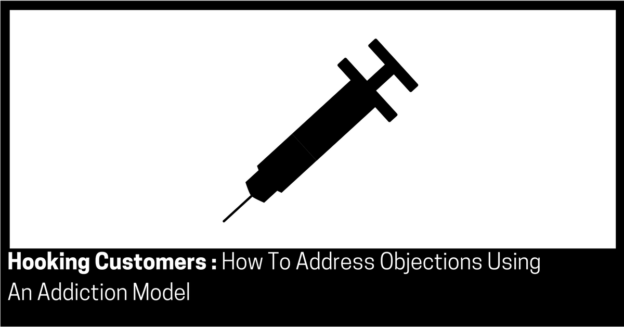Approximate read time: 4 minutes
Once you have built trust and rapport, you then have the ability to overcome objections effectively.
Drug dealers, particularly those that feed addictions to, for example, heroin and methamphetamine users, give away samples of their wares knowing full well that their prospects will be back next time to pay for more product.
The Cycle of Addiction looks like this:
- Pain;
- Drug use;
- Gain/high;
- Crash/come down
- Bigger pain than before;
- Drug use with increased does;
- Bigger Gain/high than before;
- Bugger crash/come down and
- Repeat indefinitely…
They are hooked.
The bigger highs and lows and the bigger the dose is what creates dependence.
It’s important to note that drug dealers don’t give people drugs to get them hooked.
The user already wants the drug, they opt-in to the dealer.
The Addiction Model can be used to determine and address concerns.
Determining and addressing concerns before you close a prospect is important, so there is no buyer’s remorse.
Objections come up when people:
- See an opportunity, but have no need and this is reflected by saying “not now”; or
- Have a need, but don’t see an opportunity and this is reflected by saying “too expensive.”
Objections are overcome when there is a need and an opportunity.
This is done through providing more information or more rapport.
Concerns usually occur at the level of discussing feelings & emotions.
Here is the broad Hooking Customers process:
- Trial Close;
- Determine the objection;
- Address the objection;
- Repeat 2 times;
- Close; and
- Repeat 2-3 one more time.
Once you have presented your product, service or solution, you then should ask for a Trial Close.
If the prospect accepts the product, service or solution, move on to the full Close step.
If the prospect does not accept the product, service or solution, move on to the Negotiation step, starting with determining the objection, then answer their objection and negotiation with them:
- Find the concern by baiting them to invest with a slight push;
- They will respond to any concerns; and
- You reflect the concern back to them to show you understand.
If tell know you have understood the concern then you address the objection:
- You resolve the concern by providing more information or more rapport;
- You acknowledge you both got through the conflict; and
- You anchor that good feeling.
Once you have answered their objection and negotiated with them, the prospect has an increased chance of accepting the solution now.
You repeat this at least 2 more times to uncover any other hidden concerns.
You then need to ask the Close again.
If the prospect still does not accept the product, service or solution, you need to move back to the Negotiation step and repeat.
And if the prospect does accept the product, service or solution, you should check again to uncover any other hidden concerns, as you don’t want them to come back and bite you after the sale in the form of buyer’s remorse.
From here you can start to more Gain Customer Loyalty.
lty.

